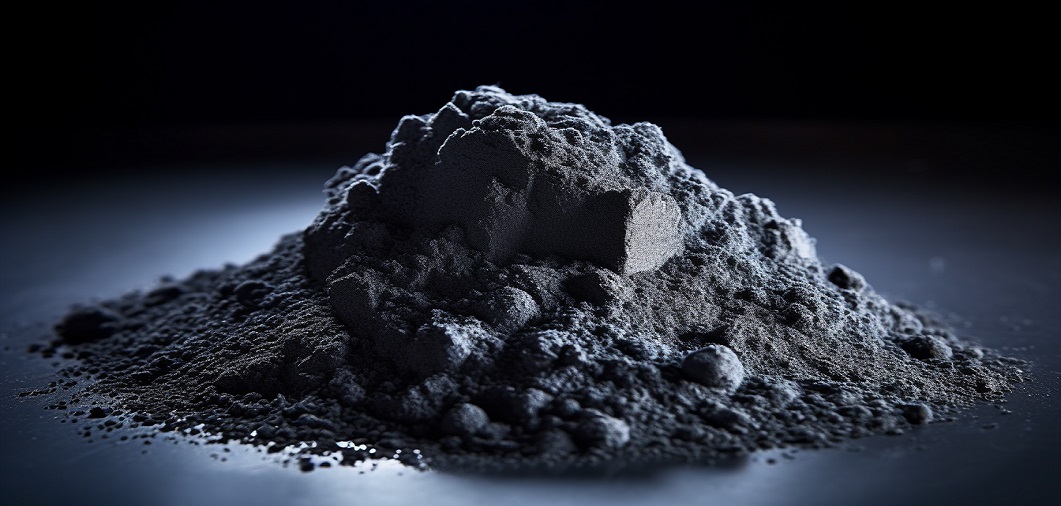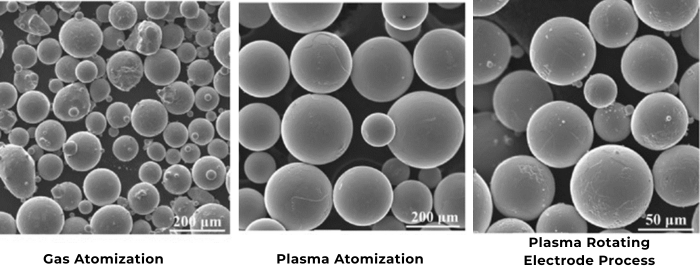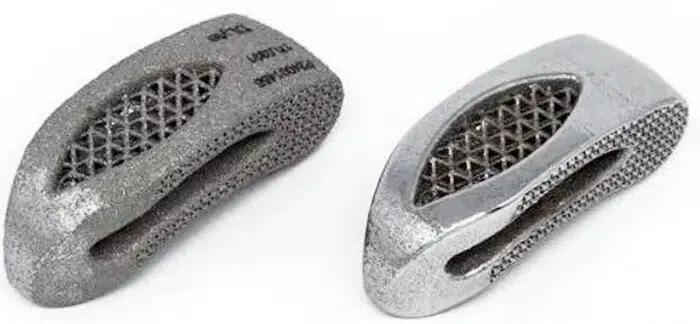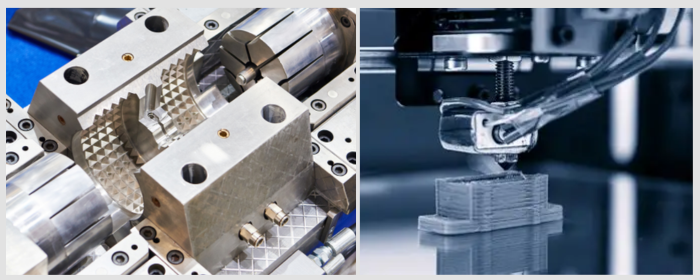

With the rapid advancement of modern industry and technology, the demand for powder materials with enhanced properties has been on the rise across different sectors. Apart from requiring extremely low impurity content, finer particle size, and narrower particle size distribution, powder materials also need to exhibit specific particle morphology. Spherical powders, because of their outstanding performance in surface morphology, particle size distribution, and flowability, have found wide applications in high-end industries.
Compared to irregular-shaped powders, spherical powders offer several significant advantages.
1. High-Quality Surface:
During processing, spherical particles are less likely to develop sharp edges and corners, reducing the formation of surface defects and microcracks. As a result, spherical powders can reduce mold wear during production processes, with a generally high surface finish. This characteristic helps in processes like 3D printing and thermal spraying to achieve smooth and uniform surfaces, enhancing product quality and aesthetics.
2. Excellent Flowability:
Due to their symmetrical shape and lower surface area friction, spherical powders exhibit exceptional flowability. This property makes it easier for them to move and fill spaces in various processing and application processes. In powder metallurgy, this feature significantly improves the density of molded parts. Additionally, in processes like 3D printing and injection molding, the high flowability of spherical powders ensures uniform distribution and deposition, ensuring consistency and quality in the final products.
3. Enhanced Processing Performance:
Spherical powders can uniformly transmit pressure during compaction, reducing internal defects and voids. With a narrow particle size distribution and high surface area, spherical powders help enhance diffusion rates and densification during sintering processes. Therefore, using spherical powders can shorten sintering times and reduce energy consumption.
4. High Packing Density:
Spherical powders can pack tightly, reducing porosity. Using spherical powders enhances material density, thereby strengthening mechanical properties and material strength.
.png)
Fig 1. Particle morphologies of alloy powder (a) spherical and (b) irregular in shape[i]
Spherical powders exhibit excellent properties because of their surface morphology, particle size distribution, and fluidity. As a result, they are widely used in high-end industries.
Refractory metals refer to metals with melting points above 1650°C and certain reserves. Metals like titanium, tungsten, tantalum, and molybdenum fall under this category. Spherical refractory metal powders have become core materials for metal 3D printing due to their excellent properties. With the rapid development of metal 3D printing technology, the market for spherical refractory metal powders continues to grow significantly.
1. Spherical Titanium Powders:
Spherical titanium powders have extensive applications in additive manufacturing (3D printing), especially in the aerospace and medical fields. Its high strength, lightweight, and excellent corrosion resistance make it an ideal material for manufacturing aerospace components and medical implants (such as bones and joints). The uniform particle size distribution and high flowability of spherical titanium powders ensure precision and surface quality during the 3D printing process, enhancing mechanical properties and product longevity.
2. Spherical Tantalum Powders:
Spherical tantalum powders are primarily used in the electronics industry, particularly in manufacturing high-performance capacitors and ultra-high-purity tantalum sputtering targets. Tantalum possesses excellent conductivity and corrosion resistance, making it a key material for high-performance electronic components. Additionally, spherical tantalum powders find applications in the medical field for manufacturing biocompatible materials used in surgical instruments and medical implants, ensuring long-term stability within the human body.
3. Spherical Tungsten Powders:
Spherical tungsten powders exhibit exceptional performance in high-temperature and high-strength applications and are widely used in aerospace and electronics industries. Its high density and high melting point make it an ideal material for manufacturing rocket nozzles, tungsten electrodes, and high-performance cutting tools. The high flowability and uniform particle size distribution of spherical tungsten powders enhance the density and strength of materials during powder metallurgy and thermal spraying processes, ensuring reliable performance under extreme conditions.
.png)
Fig 2. Spherical Refractory Metal Powders
Spherical metal oxide powders refer to metal oxide particles with approximately spherical shapes. The characteristics of spherical particles make them an ideal choice for various industrial applications.
1. Spherical Aluminum Oxide Powders (Al₂O₃):
Aluminum oxide is widely used in ceramics manufacturing, cutting tools, and refractory materials due to its high hardness and excellent wear resistance. Among different morphologies of aluminum oxide powders, spherical powders significantly enhance the mechanical strength and wear resistance of products. In ceramic manufacturing, spherical aluminum oxide powders can pack more densely, improving the density and strength of ceramics, suitable for high-demand wear-resistant components. In electronic components, spherical aluminum oxide powders are used to manufacture insulating substrates, providing excellent electrical insulation and thermal conductivity, and ensuring the reliable operation of electronic components.
2. Spherical Magnesium Oxide Powders (MgO):
The application performance of magnesium oxide products in various fields is closely related to the morphology and size of raw material powder particles. Among different morphologies of magnesium oxide particles, spherical particles are regular in shape, with uniformity, a relatively large specific surface area, and good sphericity, greatly improving the adsorption, thermal conductivity, and catalytic properties of products. In thermal conductive materials, spherical magnesium oxide has a higher filling density and can achieve a higher thermal conductivity coefficient when compounded with PVC.
3. Spherical Zinc Oxide Powders (ZnO):
Zinc oxide powders are widely used in pharmaceuticals, cosmetics, rubber industries, and photocatalytic materials due to their excellent antibacterial and photocatalytic properties. The spherical morphology significantly enhances the antibacterial and photocatalytic properties of zinc oxide. In the pharmaceutical field, spherical zinc oxide powders are used to prepare antibacterial ointments and skin disease treatment drugs, providing effective antibacterial effects. In cosmetics, spherical zinc oxide serves as a component in sunscreens, offering a uniform and effective barrier against ultraviolet rays. In photocatalytic materials, spherical zinc oxide powders are used for water and air purification, enhancing the efficiency and effectiveness of photocatalytic reactions.
Currently, spherical silicon micro powders are widely used in large-scale integrated circuit packaging. They are gradually being applied in high-tech fields such as aerospace, fine chemicals, and special ceramics. Spherical silicon micro powders are an important filler in epoxy resin systems, reducing epoxy resin consumption by at least 30%, and have promising market prospects.
Advantages of Spherical Silicon Micro Powders:
Because of their good powder surface flowability, they can increase the powder filling amount in integrated circuit packaging. This results in a lower coefficient of thermal expansion, better dielectric capability, longer lifespan for electronic devices, and improved performance.
The low-stress concentration in the plastic sealing formed after spheroidization leads to a high yield rate. This advantage can shorten the production cycle and reduce the likelihood of product damage during transportation and other processes.
In conclusion, spherical powders have revolutionized various industries with their unique advantages, including high-quality surfaces, excellent flowability, enhanced processing performance, and high packing density. Their impact on manufacturing processes and product quality is undeniable, making them essential materials for driving progress and excellence across sectors. As industries embrace the potential of spherical powders, they open doors to enhanced product development, increased efficiency, and superior performance. These powders will continue to play a crucial role in shaping the future of advanced manufacturing and technology, enabling the creation of high-performance products with unmatched precision and quality.
Stanford Advanced Materials (SAM) is committed to promoting research and innovation in the field of spherical powder technology. We offer various types of spherical powders, such as various spherical refractory metal powders, spherical alumina powders, spherical silicon micro powders... For more information about these powders, please contact us and check out our page.
[i] Gülsoy, H & Gülsoy, Nagihan & Calışıcı, Rahmi. (2014). Particle morphology influence on mechanical and biocompatibility properties of injection molded Ti alloy powder. Bio-medical materials and engineering. 24. 1861-73. 10.3233/BME-140996.







